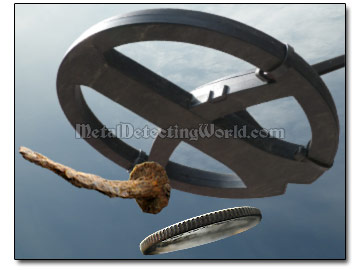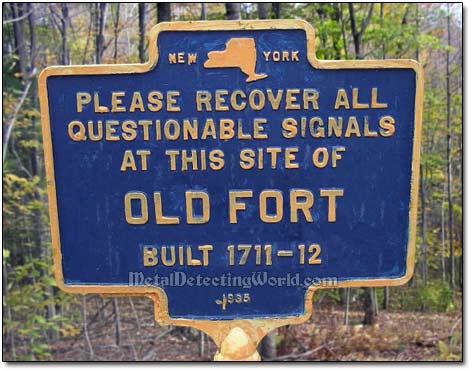Questionable Target Signals
Learn All Types of Ambiguous Responses To Targets and How To Decipher Them

Today's most advanced metal detectors incorporate a number of quite effective features to handle responses to QUESTIONABLE targets. The Minelab FBS metal detectors were in the lead for a decade because of their FBS and Smartfind2 technologies. However, on the today's market, since a revolutionary high-frequency XP Deus appeared, all Minelab FBS metal detectors, except one - CTX 3030, have been pushed out of leadership in target separation and recognition because their recovery speed (1-1.5) is lower than the Deus' (up to 7!). Users of detectors of other brands either have to spend additional time and efforts digging up targets to investigate the questionable signals or just leave the "difficult" signals behind.
Even if you do not own an advanced metal detector, you can still decipher most of questionable responses using a couple of old and effective techniques described in my articles: "Masked Targets Detecting Technique" and "Target Identification Techniques". This article may help you learn and understand the nature of most questionable signals so that you would be theoretically prepared to deal with them in real metal detecting situations.
Users of XP Deus and other "tonal" metal detectors with a 1-Dimensional Discrimination Scale can learn how to handle questionable signals by methods and techniques described in an article #4 listed below.
Users of Minelab E-Trac and CTX 3030 metal detectors with a 2-Dimensional Discrimination Scale can learn how to handle questionable signals by means of certain features and modes of their metal detectors and by using simple and effective techniques described in articles #2 and #3 respectively.
TABLE of Contents:
1. Types of Questionable Target Responses - page 1
2. How To Discern Responses to Coins Lying Close to Nails with Minelab E-TRAC - page 2
3. How To Discern Responses to Coins Lying Close to Nails with Minelab CTX 3030 - page 3
4. How To Decipher Questionable Responses to Targets with XP Deus - a separate article in "Part II: Valuable Practical Tips for Metal Detecting with Deus"
1. TYPES OF QUESTIONABLE TARGET RESPONSES
When you receive a questionable signal of the Coin+Nail type, you are likely to hear either of these two almost repeatable audio responses:
1) initially a "broken" and "one-way" signal of a high-pitched tone AND nulling of Threshold if the iron nails or iron objects of a similar size are REJECTED in the Discrimination pattern;
As soon as you isolate the high-tone signal by approaching the spot with a search coil from different directions and using very short spans of coil passes, the signal becomes "two-way" repeatable.
2) a "broken" and "one-way" signal of a high-pitched tone AND a low-tone iron response to a nail if nails are ACCEPTED;
Like in the first case, as soon as you isolate the high-tone signal by approaching the spot with a search coil from different directions, the signal becomes "two-way" repeatable.
NOTE: In many cases, rusty wrought nails with large heads and square nails (cast iron) can cause the two-way repeatable audio responses of the Coin+Nail type due to their characteristic ability to exhibit both ferrous and conductive properties. They can be identified using accurate pinpointing: if the actual center (highest tone pitch and maximum volume) of the pinpoint audio response to the target is not where the center of the isolated high-tone signal was located during detection, the target is a rusty nail.
It is best to dig up these questionable signals to be sure before you master this technique. Just keep in mind that there are many variables "in the equation", and a number of possible "coin+nail" positions in the ground is infinite.
The above-mentioned responses should NOT BE CONFUSED with the following types of false coin-like signals:
1) Halo Effect type of IRON FALSING, also called "iron crackling" (read details in my "Halo Effect" article);
2) Wrap Around Effect type of IRON FALSING, which is characteristic for the FBS detectors (see description of this effect in my "E-Trac Field-Test Report" page 2).
NOTE: Both types of IRON FALSING may be represented by broken and inconsistent signals of high tones due to partial discrimination of iron objects.
3) Ground Falsing occurs in some cases of the high-mineralized ground or/and when the MANUAL Sensitivity is set too high, or the Ground Balance is improperly adjusted.
4) Hot Rock responses should be muted by Secondary Discrimination zones especially created in your Discrimination and QuickMask patterns. However, very often the deepest coins in magnetic ground are identified by a metal detector as hot rocks because they have a similar "signature". So rejecting the hot rocks can be a "catch-22" situation (an example is given on page 10 of my description for the 3-Level Search Program for Minelab CTX 3030 and E-Trac)
5) Large-Sized Iron Targets are usually responded to with "solid" coin-like signals because the target size always affects conductivity rating for objects: the larger the target, the higher the corresponding conductivity rating. The large-sized iron targets should be dug up as they may be valuable relics, or they may mask a few coins underneath.
6) Target's Oxidation/Rust may cause falsing. Iron and iron alloys can rust to a high degree causing the targets to exhibit both conductive and ferrous properties. This results in appearance of alternating (bouncing) high/low CO read-outs on the Smartfind and Smartfind 2 screens with mixed Audio ID responses.
7) External metal objects such as steel toes or steel shanks inside your boots may cause false signals every time a search coil passes by your feet. Same goes for the long-handle shovels dragged on a side, and hand jewelry that one forgets to take off before manually scanning lumps of dirt in front of the search coil.
Questionable responses to coins may be caused by the following:
1) Coin is in vertical position - "standing" on its edge, in the ground: the coin's audio response still may be of the high-pitched tone but broken, double-beep or just a one-way signal. You can get a better coin response by tilting a search coil 20° while sweeping it over the target spot from different directions (you may want to read my article "Search Coil Detecting Techniques: Pinpointing Coins On Edge").
2) Coin is buried too deep for the metal detector to obtain enough target information for accurate identification. As a result, the detector exhibits coin's incorrect FE-CO properties; with FE numbers sometimes reaching values up to 27. The detector's audio response to this coin may be either a broken and low-pitched tone, or very short and high-pitched tone, or just a "bleep" with the Threshold going "blank".
If you are searching at the hot coin spot and willing to physically fast-exhaust yourself investigating every "difficult" signal, you may want to remove 3-4 inches of surface soil at the signal spot to reduce depth, and rescan the spot with a search coil to get a better audio response.
3) Coin is "disguised" by high mineralization in the ground. The detector's response to the coin may be distorted the same way as in previous case, or indicated only by nulling of the Threshold. If you are searching at the hot coin spot, perform the above-described simple procedure to reduce an amount of mineralization separating the search coil and the coin, and try to get any audio response.
It is always best to get to know the sounds of various questionable signals and good targets before you dig them up at the hunt site which you are not familiar with because the ground mineral content may be radically different from your usual hunt areas or your Test Garden at home.
